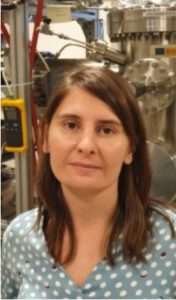
Dr. Ana Isabel Borrás Martos
Multifunctional plasma-enabled functional thin films low dimensional nanoarchitectures: from synthesis to devices
Multifunctional plasma-enabled functional thin films low dimensional nanoarchitectures: from synthesis to devices
Xabier García-Casas, Javier Castillo-Seoane, Jaime del Moral, Gloria P. Moreno, Triana Czermak, Laura Montes, Jorge Gil-Rostra, Victor Rico, Francisco J. Aparicio, M. Carmen López-Santos, Juan R. Sanchez-Valencia, Angel Barranco, Ana Borrás*
*Nanotechnology on Surfaces Lab, Materials Science Institute of Seville / Consejo Superior de Investigaciones Cientificas – University of Seville (CSIC – US), Spain
In this presentation, we will present our last advances in the exploitation of plasma and vacuum deposition methods for the nanoengineering of thin films and supported low-dimensional materials. A key step in the development of such nanoarchitectures is the implementation of a soft-template procedure based on the use of single-crystal small-molecule nanowires grown on processable substrates under mild conditions. We will demonstrate the application of vacuum and plasma-assisted deposition techniques to develop complex nanowires (NWs) and nanotubes (NTs) with a core@multishell morphology where each shell adds functionality or multifunctionality to the system. The steps required for the integration of these nanomaterials as supported or in-device applications will be presented. Two final applications will drive the presentation, namely, the development of multisource energy harvesters (piezo, solar, pyro and triboelectric) and novel approaches for smart surfaces and efficient de-icing by acoustic waves. The universal character of vacuum and plasma methods allows for the deposition of an unprecedented variety of possibilities, including, organic (small-molecules, organic nanocomposites, polymeric layers), inorganic (metal and metal oxides), hybrid (hybrid perovskite) materials acting as conducting, semiconducting, dielectric, photo-absorbent, piezoelectric or plasmonic components in a multilayer or radial configuration. We will share the results accomplished during the last years in the field of energy harvesting (solar cells,[1-4] piezoelectric and triboelectric nanogenerators[5-7]), semi-transparent nanoelectrodes,[8] wetting [9], de-icing and anti-icing.[10-11]
References
- Filippin, A., Sanchez-Valencia, J., Borras, A. et al. (2017) Nanoscale, 9:8133-8141.
- Barranco, A., Borras, A., Sanchez-Valencia J. R. et al. (2020) Adv. Ener. Mater 10:1901524.
- Castillo, J., Borras, A., Sanchez-Valencia J.R. et al. (2022) Adv. Mater. 34:2107739.
- Obrero, J., Borras A., Barranco, A. (2022) Adv. Ener. Mater. 12:2200812.
- Filippin, A. N., Borras, A. et al. (2019) Nano Energy 58:476-483.
- García-Casas, X., Borras, A. et al. (2022) Nano Energy 91:106673.
- García-Casas, X. Borras, A. et al. Patent application Self-powered triboelectric transductor device for drops and liquids. EP23382176.8
- Castillo-Seoane, J., Borras, A. et al. (2021) Nanoscale 13:13882.
- Montes, L., Borras, A. et al. (2021) Adv. Mater. Interf. 21:2100767.
- Lopez-Santos, C., Borras, A. et al. (2019) Langmuir 35:16876.
Del Moral, J., Montes, L., Borras, A. et al. (2023) Adv. Funct. Mater. 2023, 2209421
Since 2011, Ana Borras is a tenured scientist in the Spanish National Scientific Council (CSIC).
After completing her Ph. D. at the University of Seville (2007) she moved to EMPA-ETH Thun to work in the synthesis of small-molecule nanowires and organic nanocomposite thin films.
She currently belongs to the Nanotechnology on Surfaces Laboratory of the Materials Science Institute of Seville (ICMS) where she leads the research line Multifunctional One Dimensional Nanomaterials devoted to the development and applications of complex hybrid and heterostructured 1D and 3D materials fabricated by vacuum and plasma deposition methods.Ana Borras holds the ERC Starting Grant 3DScavengers aimed at the fabrication of multisource energy harvesters and hybrid nanogenerators. Besides, she is the international coordinator of the FET-Open project SOUNDofICE (2020-2024) aimed to demonstrate a pioneering strategy based on the surface engineering of MHz Acoustic Waves for a smart and sustainable removal of ice, with impacts in aeronautics and wind energy. She has more than 90 articles with h-index 29, and contributions D1 journals, including Progress in Materials Science, Advanced Materials, Advanced Energy Materials, Advanced Functional Materials, Nano Energy, Chemistry of Materials, ACS Appl. Mat. Interf, Nanoscale and J. Physical Chemistry C. She has participated in and led more than 20 projects for the Industry. She has co-authored 3 patents, and supervised 4 PhD Theses. She has been appointed Spanish representative of the IUVSTA (Plasma Science and Technology Division), belongs to the Scientific Committee of the Spanish Vacuum Association (ASEVA) and is member of the Plasma Nanoscience Foundation (iPlasmaNano).
Prof. Dr. Maria Chiara Spadaro
Advanced (S)TEM investigations of nanomaterials for green energy production
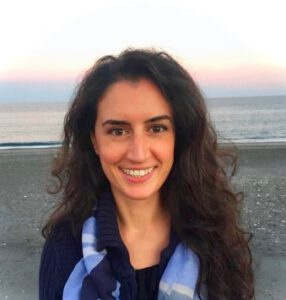
Advanced (S)TEM investigations of nanomaterials for green energy production
Spadaro Maria Chiara
Department SIMAU, Marche Polytechnic University, Ancona, Italy
Catalan Institute of Nanoscience and Nanotechnology (ICN2), CSIC and BIST, Campus UAB, Bellaterra, 08193 Barcelona, Catalonia, Spain.
The development and optimization of growth processes, that allow to control shape and size of the produced nanostructures, is an aspect of major interest in material science and nanotechnology. Nanostructures with desired morphological, structural and chemical features exhibit specific properties that can be exploited in several research fields, such as catalysis, photovoltaics and so on. Transmission electron microscopy (TEM) is ideal thanks to the possibility to obtain information on nanostructures with high spatial resolution, down to the atomic scale. To unambiguously investigate specific TEM or STEM image characteristic features, 3D atomic modelling and EM image simulation are required.
Here some of our results for nanoparticles and nanowire structures. By combining scanning transmission electron microscopy in high angle annular dark field (HAADF-STEM) mode, with modelling and simulation we could recognize the presence of specific features that need to be deeply investigated and addressed to unveil their formation mechanism and their effects reflected in the final device electronic properties.
Maria Chiara Spadaro graduated in Condensed Matter Physics at the University of Messina and obtained her PhD in Physics and Nanoscience at the University of Modena and Reggio Emilia in 2016. Her PhD research was awarded to the Best PhD Thesis SISM Award for Transmission Electron Microscopy applied to Material Science. In 2018 she received Laura Bassi SIF Award, and other Awards related to her scientific outcomes. In 2018 she joined the group of Prof Richard Palmer at the Swansea University (UK) and in 2019 she joined the group of Prof Jordi Arbiol at the Catalan Institute of Nanoscience and Nanotechnology (ICN2), where in 2022 received the ‘To the Mothers of Science’ Award. Since 2019 she is Honorary Research Fellow at the Swansea University. In August 2022 she became an Assistant Professor (RTDb) at the Marche Polytechnic University and Visiting Professor at ICN2. She gathers expertise in transmission electron microscopy-based investigation, including both structural and chemical studies of nanostructured materials with diverse application, in addition to catalysis, energy and magnetism. These studies are complemented with 3D atomic model creation and (S)TEM image simulation, in order to get an atomistic view of the investigated system and unveil the main image features.
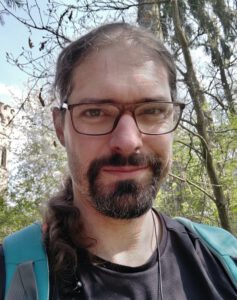
Dr. Jaroslav Kousal
Charles University, Czech Republic
Czech Technical University of Prague, Czech Republic
Exploration of the gap between classical and plasma polymers: fundamental and applied science opportunities
Exploration of the gap between classical and plasma polymers: fundamental and applied science opportunities
Jaroslav Kousal, Zdeněk Krtouš, Pavel Solař, Ivo Křivka, Ivan Krakovský, Suren Ali-Ogly, Lenka Hanyková
Department of Macromolecular Physics, Faculty of Mathematics and Physics, Charles University, Prague, Czech Republic
Plasma polymerization (plasma-enhanced chemical vapour deposition) is a well-known method for depositing organic thin films. One of its drawbacks is typically a limited molecular complexity of the films compared to those obtained from classical chemistry. This is partially caused by the need to use the precursors with sufficient vapour pressure and, therefore, a limited molar mass. To overcome this limitation, plasma-assisted vapour thermal deposition (PAVTD) has been developed [1].
PAVTD uses a solid polymer in a crucible to obtain oligomers through thermal degradation/evaporation, which are then re-polymerized in RF plasma. Using heavy (several monomeric units) building blocks, the chemical structure of the original polymer is largely preserved. In this way, PAVTD utilizes both top-down and bottom-up processes. This approach allows control of the properties like biodegradability and hydrolyzability in a very broad range, as was demonstrated using polylactic acid (PLA) [2, 3]. Effectively, PAVTD films bridge the gap between the classical and plasma polymers. The batch process is limited in deposition duration and stability. However, Yasuda-like scaling law was already reproduced in PAVTD [4]. Recently, a continuous-PAVTD was developed, utilizing common FDM 3D printing filaments (Fig. 1). With improved stability and deposition rate, PAVTD can become both a practical deposition method and a tool to study plasma polymerization processes.
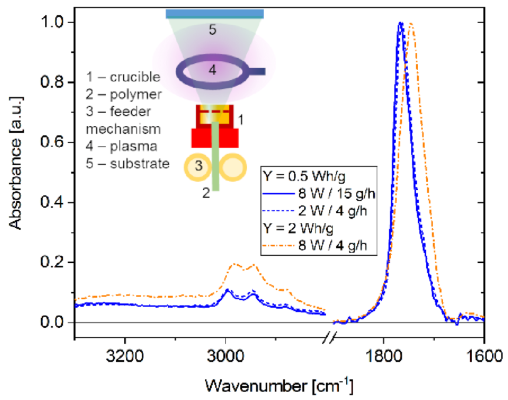 Fig. 1. Infrared spectra of PLA-like films prepared using PAVTD. Inset: Simplified scheme of the PAVTD setup with continuous feed.
Fig. 1. Infrared spectra of PLA-like films prepared using PAVTD. Inset: Simplified scheme of the PAVTD setup with continuous feed.
Keywords: Plasma polymer, plasma-assisted vapour thermal deposition
Acknowledgements: This contribution was supported by the grant GA22-21007S of the Czech Science Foundation.
References:
[1] Choukourov et al., Vacuum 2006, vol. 80, pp. 923–929
[2] Krtouš et al., Materials, 2021, vol. 14, pp. 459.
[3] Krtouš et al., Surface and Coatings Technology, 2021, vol. 421, 127402
[4] Kousal et al.,Vacuum 2020, vol. 173, 109062
Jaroslav Kousal graduated from Masaryk University in Brno and obtained his Ph.D. in 2006 at Charles University, Prague, Czechia. He is now part of the staff as an Assistant Professor. He has also a partial appointment at the Czech Technical University in Prague. He is the author or co-author of more than 70 papers. His main professional interests are plasma polymerization and magnetron sputtering of polymers, plasma and thin film characterization and processes in gas-aggregation sources of nanoparticles. More recently, he also entered the field of space technologies.
Dr. Lidia Martinez
Tuning Ag-Au structures at the nanoscale
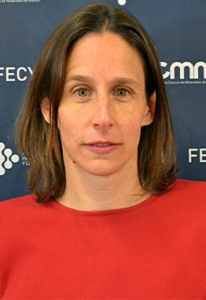
Tuning Ag-Au structures at the nanoscale
Covadonga Álvarez1, Yves Huttel1, José Miguel García-Martín2, Lidia Martínez1
1Instituto De Ciencia de Materiales de Madrid (ICMM), CSIC, c/ Sor Juana Inés de la Cruz 3, Madrid-28049, Spain.
2Instituto de Micro y Nanotecnología (IMN) CSIC, Isaac Newton 8, 28760 Tres Cantos (Madrid), Spain
Silver and gold nanostructures are subject of intensive research due to their interesting properties at the nanoscale, which make them particularly suitable for many different applications ranging from catalysis, nanomedicine, optics, sensing, etc [1,2]. Like the formation of alloys that combines the properties of different elements resulting in novel materials, the combination of different shapes and dimensions also leads to materials having novel properties, especially at the nanoscale. In this talk we will present different combinations of silver and gold nanostructures. In particular, nanocolumns (NCs) fabricated by Glancing Angle Deposition with magnetron sputtering [3], nanoparticles (NPs) fabricated by means of a Multiple Ion Cluster Source (MICS) [4] as well as combinations of NCs with NPs [5]. We will first briefly present the ultra-high vacuum physical methods used to grow the NCs and NPs, highlighting the control over chemical composition, shape and dimensions of the fabricated nanostructures. Later, we will present some examples of application of these systems, including photo-induced self-cleaning surfaces [5], antibacterial coatings [6], controlled wettability or catalysis.
Keywords: nanoparticles, nanocolumns, gas-phase synthesis, glancing angle deposition, dual scale roughness
References:
- A. Nieto-Arguello et al., Nanomaterials 12 (2022) 779;
- L. Armelao et al., Coord. Chem. Rev. 250 (2006) 1294.
- G. Troncoso et al., Appl. Surf. Sci. 526 (2020) 146699.
- L. Martínez et al., Langmuir 28 (2012) 11241.
- F. Fresno et al., Adv. Sustainable Syst. 5 (2021) 2100071.
- D. Medina-Cruz et al., Nanomedicine: Nanotechnology, Biology, and Medicine 17 (2019) 36
Distinguished Researcher at the Materials Science Institute of Madrid (ICMM), from the Spanish National Research Council (CSIC). After completing her European PhD in Materials Science and Technology (Universidad Complutense de Madrid), she started working on the fabrication and characterization of low dimensional materials at the ICMM. In 2012, she was guest researcher at the Université de La Rochelle (France). In 2013 she started working at Next-Tip, a spin-off company of which she is a founding partner, developing high added value SPM probes. In 2015 she returned to the ICMM to work on the design, assemble and commissioning of Stardust, a unique UHV experimental setup to fabricate and characterize cosmic dust analogs, in the framework of the ERC Synergy Nanocosmos project. The main module of this equipment, is a scaled-up Multiple Ion Cluster Source (MICS), a type of gas aggregation source which she developed together with Yves Huttel at the Low-Dimensional Advanced Materials group at the ICMM. Most of her activity is focused on the study of nanoparticles, including their production using gas aggregation sources, their characterization using techniques such as X-ray photoemission spectroscopy (XPS) or atomic force microscopy (AFM) and their applications in fields such as nanomedicine, energy, catalysis or astrophysics. She is the author of more than 65 scientific articles and 5 book chapters, co-inventor of 5 patents and co-founder of two spin-off.
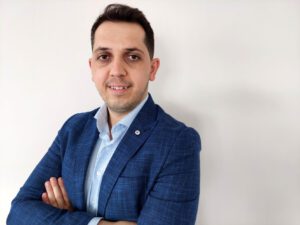
Dr. Salih Vaziroglu
Kiel University, Germany
Functional Metal Oxide Surfaces: Photocatalytic, Self-Cleaning, Sensing, and Micro-/Nanostructuring Applications
Functional Metal Oxide Surfaces: Photocatalytic, Self-Cleaning, Sensing, and Micro-/Nanostructuring Applications
Salih Veziroglu,1 Josiah Shondo,1 Tim Tjardts,1 Franz Faupel,1 Oral Cenk Aktas,1,2
1 Chair for Multicomponent Materials, Institute of Materials Science, Kiel University, 24143 Kiel, Germany
2 Additive Manufacturing Excellence Centre – URTEMM, Kahramankazan, Ankara 06980, Turkey
Titanium oxide (TiO2) is one of the most used photocatalytic materials for various applications such as environmental remediation, (solar)water splitting, and self-cleaning due to its high activity, low cost, and high chemical, and physical stability. However, the photocatalytic activity of TiO2 is limited by the wide energy of the bandgap, low quantum efficiency, and rapid recombination of photogenerated charge carriers (electrons and holes). During the last decades, numerous approaches, such as tailoring the morphology (nanoparticles, thin film, etc.), and combining with a metal, noble metal, and metal oxide micro/nanostructures, have been demonstrated to enhance the photocatalytic activity of TiO2. However, it is still a major challenge to find the best photocatalytic combination for specific applications. Recent studies have revealed that particle size plays a considerable role in the photocatalytic activity of TiO2. Reducing the particle size (increasing active surface area) indicates a higher photocatalytic activity. Nevertheless, the use of photocatalytic nanoparticles in continuous flow systems (such as water remediation, water splitting, etc.) has some practical limitations such as reusing and splitting them up from the reaction media. Hence, the use of robust and stable thin film photocatalysts becomes more suitable rather than nanoparticle systems for practical applications. Nevertheless, thin films are restricted by low surface area in contrast to nanoparticles and they show extremely limited photocatalytic activity. Here we present some case studies on enhancing the photocatalytic performance of TiO2 thin film by modification with metallic [1,2] and oxide [3,4] nanostructures for practical applications such as water purification, self-cleaning, selective oil absorption [5], and organic molecule sensing [6].
Keywords: metal oxide, functional surfaces, photocatalysis, self-cleaning, PIERS
References:
- Veziroglu et al., ACS Appl. Mater. Interfaces. 12 (2020) 14983–14992.
- Z. Ghori et al., ACS Appl. Nano Mater. 1 (2018) 3760–3764.
- Veziroglu et al., Nanoscale. 11 (2019) 9840–9844.
- Veziroglu et. al., Mater. Today Chem. 16 (2020) 100251.
- Shondo et al., Adv. Mater. Interfaces. 9 (2022) 2102126.
J. Shondo et al., Small. (2022) 2203861.
Salih Veziroglu received his Ph.D. from the Institute of Material Science at Kiel University- Germany in 2020. His Ph.D. research was awarded as the Best Ph.D. Thesis (in Engineering) by Kiel Nano Surface & Interface Science (KiNSIS) due to his outstanding achievements. Currently, he is working as a subgroup leader (Nano, Energy, and Surface Engineering Group) at the same institute. He is the author or co-author of more than 25 papers in high-ranking and prestigious journals. His main research interests are the fabrication of metal-metal oxide thin films and particles for photocatalysis, energy, self-cleaning, and sensing applications.
Dr. Shun Yu
RISE, Sweden
The structural analysis of biobased materials by X-ray scattering characterization
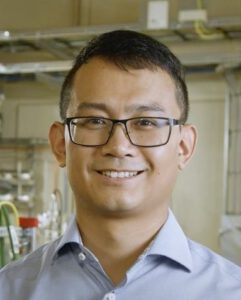
The structural analysis of biobased materials by X-ray scattering characterization
Shun Yu1,2, Jenny Bengtsson3, Hanna Ulmefors3, Omid Hosseinaei4, Andreas Bengtsson4, Jiliang Liu5
1 Unit of Smart Materials, RISE Research Institute of Sweden, Scheelevägen 17 Lund, Sweden
2 LINXS Institute of Advanced Neutron and X-ray Science (LINXS), IDEON Building: Delta 5, Scheelevägen 19, 223 70 Lund, Sweden
3 Unit of Fibre Development, RISE Research Institute of Sweden, Argongatan 30 Mölndal, Sweden
4 Unit of Lignin, RISE Research Institute of Sweden, Drottning Kristinas väg 61 Stockholm, Sweden
5 European Synchrotron Radiation Facility (ESRF), Grenoble 38000, France
The sustainable development goal calls for the materials transition from fossil-based polymeric materials to ones from renewable resources. Novel biobased materials derived from forests and agricultural plants are emerging for this purpose and have demonstrated the potential to substitute fossil-based counterparts in many applications, such as packaging, textile, energy storage, electronics, etc. Despite the bright future, some fundamental challenges of developing biobased materials remain in manipulating the heterogeneity of their components and the hierarchy of their structure, as well as handling the inherent complex interaction between biobased macromolecules and water[1]. To address these challenges, advanced X-ray scattering techniques, especially at synchrotron radiation facilities, provide many possibilities to investigate the structure variation of the material in real-time and with good spatial information, shown in Fig. 1. In this presentation, we summarize some of our recent works to investigate the water-lignocellulose interaction by coupling X-ray scattering with relative humidity/mechanics-controlled tests[2] and decipher the distribution of different biocomponents by using micro-focused scanning X-ray scattering imaging techniques[3], In addition, we will discuss the development of the hierarchical structure of carbonaceous materials derived from biobased materials in the perspective of X-ray scattering characterization[4].
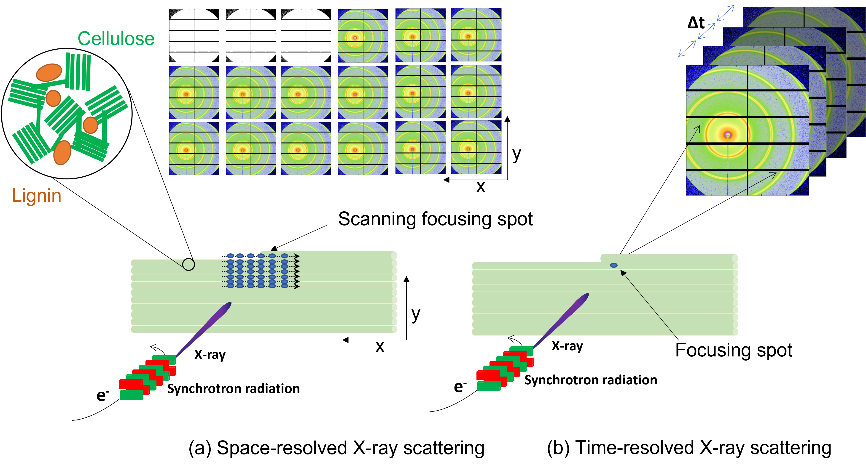
Fig. 1. Schematics of the characterization of lignocellulose material by X-ray scattering
Keywords: cellulose, lignin, SAXS/WAXS, water, hierarchical structure
References:
- L. Solhi, et al., Chem Rev. 123, 1925–2015 (2023).
- L. Salmén, et al., Cellulose. 28, 3347–3357 (2021).
- J. Liu, et al., Int J Biol Macromol. 225, 1555–1561 (2023).
- A. Bengtsson, et al., Fibers. 10, 108 (2022).
Dr. Shun Yu is a researcher at the unit of Smart Materials at RISE Research institute of Sweden. He works as a technique specialist by using scattering characterization to solve industry-relevant R&D challenges of material developments, especially biobased materials. His research interest has been in-situ/in-operando characterization of materials structure and chemical interaction both in bulk and at the interface. He obtained Ph.D. in materials physics in 2012 from Royal Institute of Technology, Sweden (KTH), where he used Soft X-ray spectroscopies (XPS, NEXAFS, RPES) to study the interaction at the interface between the organic and inorganic materials. Then he spent two years at DESY to work with Hard X-ray scattering technique (SAXS/WAXS) at with the support of Wallenberg postdoc fellowship and focused thin film structure characterization via the grazing incidence X-ray scattering (GIXS). Since 2014, he begins to work with biobased materials extensively first in Wallenberg Wood Science center, then at Stockholm University and now at RISE.